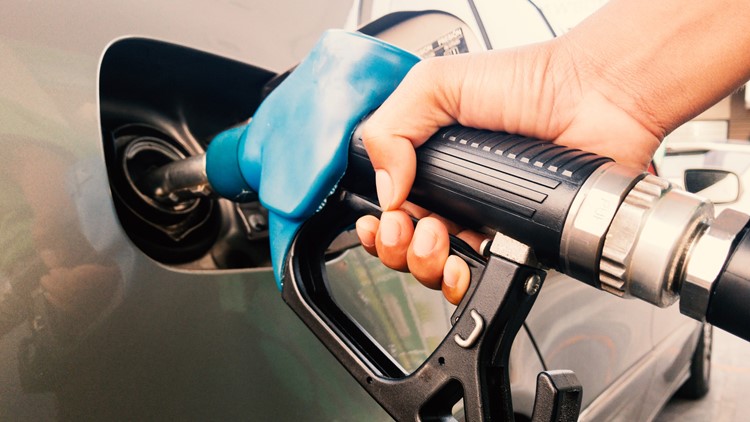PORTLAND, Ore. — Most Oregonians would likely agree: Oregon gasoline is expensive. It trends up and down, just like everywhere else, but the prices at Oregon pumps always seems to be a bit higher than in most other states at any given time — and the state's closest neighbors often find themselves in the same boat.
"The West Coast region is always in the top 10," said Marie Dodds with AAA. "We've got seven states in our region, and it's very common for those states to be first through seventh."
Some of KGW's previous reporting on gas prices has delved a bit into the reasons for this unfortunate distinction, such as the long distance between the West Coast and the Gulf Coast, the U.S.'s oil production hotbed. But that explanation didn't sit well with viewer John Larson, who recently emailed KGW to point out that Oregon and Washington import much of their crude oil from geographically closer sources. Here's what he had to say:
Oregon and Washington gas prices average around a dollar more a gallon than the national average. The crude oil for Oregon and Washington has come mainly from Alaska since the 1970s and is refined locally. So why aren't the gas prices in Oregon and Washington at the national average or lower?
We set out to VERIFY a more detailed explanation for the discrepancy Larson highlighted, looking not so much at what makes the prices go up and down, but why Oregon's prices in particular always seem to be comparatively high. We landed on five major factors that tend to make Oregon gas extra pricey.
THE SOURCES
WHAT WE FOUND
The West Coast lacks local crude oil sources
Oregon, Washington and Hawaii are not crude oil producers — according to a 2022 ranking from the U.S. Energy Information Administration, each of those states produced zero barrels the year before. Idaho, Nevada and Arizona are also lightweights, producing fewer than 250 barrels combined. And that's not a policy choice — there simply aren't any big oil deposits beneath those states, as shown in a map from a 2020 Oregon Department of Energy Report.
But the same doesn't go for the rest of the western and pacific states. That same EIA ranking put Alaska in fourth place for 2021, accounting for 3.9% of U.S. production, and California wasn't too far behind, producing about 135,000 barrels to Alaska's 160,000. The Canadian oil production powerhouse of Alberta is also at least sort of close by.
But in relative terms, the West Coast represents a fairly small slice of U.S. oil production. The top three producers — Texas, New Mexico and North Dakota — collectively churn out nearly two thirds of the country's crude oil, with North Dakota alone producing more than all the West Coast states combined in 2021, according to the EIA ranking. Offshore drilling in the Gulf of Mexico accounts for about another 15%.
Still, the West Coast collectively produces enough oil to get by at least partially on its own, which gets back to Larson's point. A breakdown from the Oregon Department of Energy report showed that imports from Alberta and Alaska account for a large majority of the crude oil that ultimately becomes gasoline sold in Oregon, with North Dakota emerging as another prominent source in the past decade.
Gas has to travel farther to get here
Here's where we get into the issue of Oregon's high gas prices. The state's lack of crude oil production means all of its gas needs to be imported, and that's a much more expensive endeavor than in other states that are geographically closer to the Gulf Coast.
The Rocky Mountains create a natural barrier that makes piping oil more difficult — a map of major liquid pipelines from the American Petroleum Institute shows a dense network of pipelines spiderwebbed across the South and Midwest to cheaply distribute oil and gas from the Gulf Coast, but with much less connectivity to the West Coast.
"When you look at the West Coast, it's kind of barren," said Dodds. "You know, we've got the Olympic pipeline and the handful of refineries. But definitely, we live in a part of the country where we do not produce as much as other parts of the country."
Most of the crude oil that ultimately ends up in Oregon gas tanks doesn't come from the Gulf Coast anyway — as mentioned above, the lion's share comes from the geographically closer sources of Alaska, North Dakota and Alberta. But two of those three are still on the wrong side of the Rockies, and the third can only be reached by sea.
As a result, a significant majority of the Pacific Northwest's crude oil is brought in by ship or rail rather than by pipeline, according to the Oregon Department of Energy report, greatly increasing the transportation costs that are factored in to what drivers ultimately pay at the pump.
The West Coast lacks refinery capacity
This one is doubly true for Oregon, which not only produces no crude oil but also operates zero refineries to process oil into gasoline for vehicle use. About 90% of the state's gasoline comes from refineries in the Puget Sound region, according to the Oregon Department of Energy Report, and is sent down to a distribution hub in Portland via the Olympic pipeline.
Puget Sound isn't too far away, and there's a pipeline to move the gas, but here's the rub: Washington's refinery capacity is only about 3.4% of America's total capacity, meaning an outsized share of the country's finished gasoline is produced elsewhere, leading to higher surpluses in other parts of the country — and in turn, lower prices.
"When you look at the west coast in particular, our region in general tends to produce about as much gasoline as we consume," Dodds said. "We don't have vast extra amounts of gasoline on hand, so anytime our region gets hit with some sort of issue, whether it's a pipeline outage or refinery maintenance, it means that our supplies have a crimp put in them and we see our prices climb."
That situation is unlikely to change, she added, because the industry is going through a long-term shift toward electric vehicles — and West Coast states are working to accelerate that trend by committing to eventually ban the sale of combustion engine cars. An investor looking at those factors would see little reason to build any new refineries.
Environmental rules make West Coast gas more expensive
Oregon, Washington and California are all known for their strong environmental commitments, but those commitments do contribute to higher prices at the pump. Environmental regulations in all three states require the use of reformulated gas, according to Dodds.
"About a third of the gasoline sold in the U.S. is reformulated," Dodds said. "So what this means is that the gasoline, the product, tends to produce less carbon monoxide, smog, toxic air pollutants. And those products tend to cost more to produce. And of course here on the West Coast, we care greatly about the environment, so we have reformulated gasoline in most of our markets."
The Oregon Clean Fuels Program sets progressively tighter standards for the carbon emissions of fuel used in the state each year, ultimately aiming to reduce fuel emissions by 37% from 2015 levels by 2035, and according to the Oregon Department of Environmental Quality, the cost of implementing those higher fuel standards does add up to a few more cents per gallon.
State taxes make Oregon gas more expensive
It's true that Oregon and Washington both apply a tax to every gallon of gas sold, and technically those add-ons do make gas more expensive. But to be fair, that tax revenue goes straight into the State Highway Fund for road maintenance and construction projects, so drivers paying at the pump will theoretically get a return on investment in the form of smoother rides.
"In Oregon, we have a state tax rate of 38 cents a gallon," Dodds said, "and then you factor in some cities and towns can add additional taxes. For example, the city of Portland has an additional 10 cents that goes on top of that, and so obviously taxes will play a role in how much we pay at the pump."
And since the question at hand is why Oregon's gas tends to be more expensive when compared to other U.S. states, it's also only fair to note that every single U.S. state has its own gas tax.
The national average for state gas taxes is about 32 cents per gallon, according to the EIA, so Oregon's 38-cent tax does place it in the upper half of the spectrum — but Washington, California and several others states outrank it. And it's actually the East Coast state of Pennsylvania that takes the crown, with a tax of about 60 cents per gallon, according to the American Petroleum Institute.
Do you have a question or a story about Portland that you'd like us to VERIFY? Have you run into a social media post about Oregon that you'd like to see fact-checked? Drop us a line at verify@kgw.com.



